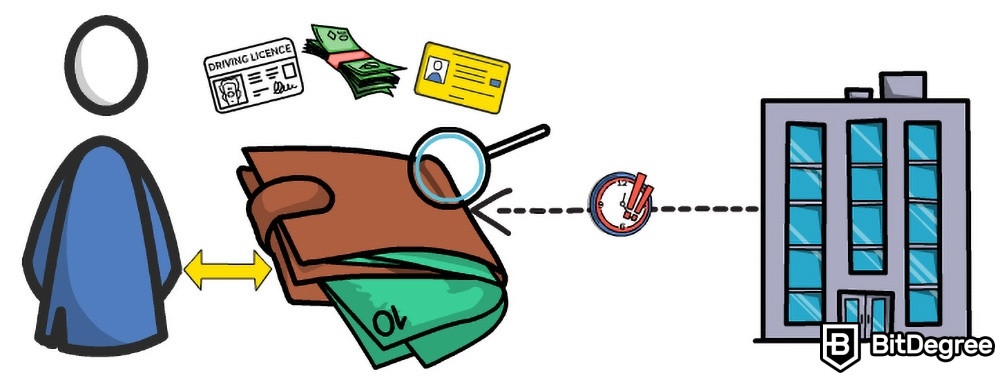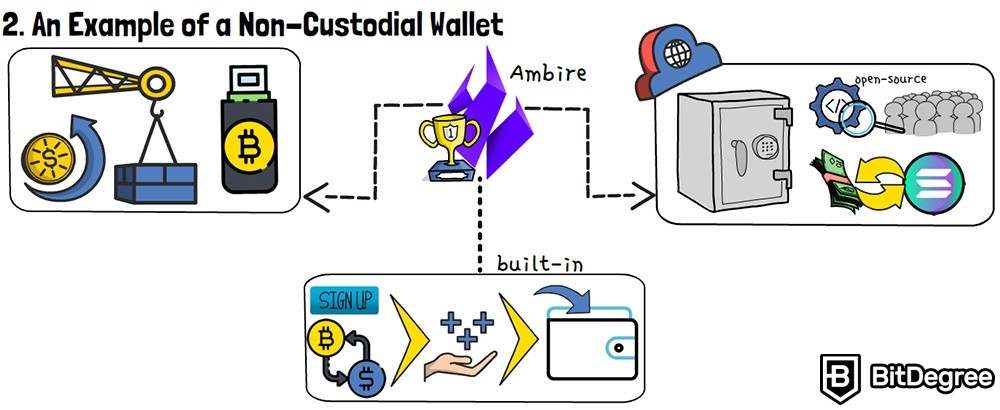What are Non-Custodial Crypto Wallets?
In this section, we’re going to explore what are non-custodial crypto wallets!
If you’ve spent even a day researching cryptocurrencies, there’s a pretty good chance that you’ve run into the concept of a crypto wallet - a place where you are able to store your crypto assets, for safekeeping and convenience purposes. Indeed, if you plan to hold even a sliver of cryptocurrency of any kind, a wallet will be mandatory!
That being said, did you know, though, that not all cryptocurrency wallets are the same? And I’m not only talking about their type or visual appearance - I’m referring to custodial and non-custodial wallets.
In this section, we’re going to talk about non-custodial wallets. Specifically, I’ll tell you what non-custodial wallets are, how they differ from custodial ones, and I’ll also give you some examples, too.
Without further ado, let’s get to it!

Video Explainer
Video Explainer: What are Non-Custodial Crypto Wallets?
Reading is not your thing? Watch the "What are Non-Custodial Crypto Wallets?" video explainer
Non-custodial Wallet: Why Do You Need It Right NOW


Two Types of Cryptocurrency Wallets
So - to start things off, before we can figure out what are non-custodial wallets, let’s first explore what does the term “non-custodial” mean.
Well, this term has a pretty wide variety of applications. In the world of crypto, though, “non-custodial” references the privacy and security of your crypto assets.

“Custodial” VS “non-custodial” are terms used to describe cryptocurrency wallets - essentially, you can view them as the two big types of wallets you’ll come across. Custodial wallets are those that can be accessed by a third party (namely, it’s usually the creators of the wallet), while with non-custodial wallets, the holder of the wallet is the only person who will be able to access it, at any point in time.
So, you can think about it this way - imagine that you have a physical wallet, where you keep your money, ID, and other important documents. YOU are the holder of that wallet, and all of its contents - whatever it may be - belongs to you.

Now, imagine that the creators of your physical wallet - the company that made it - would be able to have access to it, at any point in time. Whether you’re walking down the street to your friend’s house, or shopping at a mall, or even sleeping in your bed at night, your wallet could be “checked” by that company, whenever.
Sounds horrible, doesn’t it? Well, yes, it does - that’s the whole point!
Non-custodial wallets have become the standard in the industry - while there are certain arguments for why you would choose a custodial wallet over a non-custodial one, and we’ll cover those arguments in a minute, they are generally seen as being pretty weak and lacklustre.
An Example of a Non-Custodial Wallet
Before we get to discussing the benefits and drawbacks of non-custodial cryptocurrency wallets, I want to give you an example of what I’m talking about, so that you could have some sort of a mental image to relate to, as we move on with the explanations!
As I’ve mentioned earlier, non-custodial wallets have become the standard - it’s one of the core features that crypto fans look for, when picking out the best wallet for themselves. A great example of what I’m talking about would be a wallet called Ambire - one that is often mentioned, when talking about the best non-custodial wallets.
What is the Ambire Wallet? Well, Ambire is an application that allows you to store, send, and receive various cryptocurrencies, with ease. Now, the term “application” might not be entirely correct here - while Ambire is a web app, it works on your browser, and you would use it as a website.

So, the way that you can look at it is this - when you’re using, say, Facebook on your computer, you go to the official website of the platform, log in to your profile, and take it from there. The exact same is true with the Ambire Wallet - you don’t need to download or install anything, which is great!
The wallet prides itself on a few different things, but the fact that it’s a non-custodial way to store your crypto is definitely among the most important ones. Ambire is also open-source, which only adds to the transparency of the platform - anyone can come in and check the code behind it!
Ambire also has a load of additional features to offer, to everyone from industry newcomers, all the way to crypto veterans. The wallet has a built-in swapping and trading tool, that will allow you to purchase cryptocurrencies from within the wallet, eliminating the need to go to a designated exchange.
Think about it this way - say, your significant other has sent you to the shop, to purchase some flowers and bread. Instead of going to two different stores, you could just go to the shopping mall, purchase both the flowers and the bread there, and save yourself the extra trip.
With Ambire, you don’t need to register on a dedicated cryptocurrency exchange, fund your account, purchase crypto, and then send it to the wallet - everything can be done from the wallet interface itself! Now, there are different pros and cons associated with this, but the fact that you have the ability to do so is still a huge benefit!
Following that, Ambire also offers users cross-chain token swaps, yield earning opportunities, hardware wallet support, Ambire Wallet token airdrops, and many additional benefits. Now, if all of those terms sound completely alien to you, don’t stress - they’re some of the more-difficult crypto topics to wrap your head around! Check out other sections or the glossary of the Crypto 101 Handbook to find more information about these terms.
I’ve chosen Ambire as my non-custodial wallet example due to the fact of just how simple the feature is to understand, with this particular product. Once you create your wallet, you will be asked to download your backup file - you’re the only one who will have access to it, and thus, no one else will be able to take your crypto funds away from you (unless you get hacked or scammed, that is!).
Custodial VS Non-Custodial Wallets: Pros and Cons
Now that you have an example of a non-custodial wallet, let’s move on and talk about the actual, specific benefits that you may expect to receive, while using Ambire, and other non-custodial wallets.
First and foremost, security is probably the biggest concern that anyone looking for a cryptocurrency wallet should have. When you’re using a custodial service, there are multiple points of failure - since your data is stored with the company behind the wallet, if a hack were to occur, your information could be compromised!
Think of it as driving - if you’re using a non-custodial wallet, you’re basically behind the steering wheel. Whatever happens, you will be able to react accordingly, and won’t need to put your fate into the hands of some other driver, while you’re sitting in the passenger seat. The latter scenario would be equivalent to a custodial wallet service.
Fund access is another big point to consider, too. Usually, with a non-custodial wallet (such as Ambire), you are able to access your crypto without having to connect to the internet, while with a custodial wallet service, you would need to log in to your account, and be connected to the platform where the wallet is based.

Lastly, while this does have to do with security, it’s something that I feel like I need to mention, separately. If you were to use Ambire, or another non-custodial wallet, you would be the single owner of your secret wallet key (or a backup, depending on the wallet in question). Custodial wallets do not allow you to own that private key - instead, it is kept with the wallet’s creators.
Now, the argument that people have FOR custodial wallets is that they save you a lot of hassle - you can expect frequent updates, a smooth user experience, and other, similar features. While that is often true, especially with high-profile wallet brands, these days, non-custodial wallets can often offer a similar, if not the same level of user experience!
How to Register on Ambire?
Now that you’re aware of what are non-custodial wallets, let's circle back to the Ambire Wallet - specifically, since I’ve already told you that it’s a good example of a non-custodial wallet, I’d like to explain how you can start using the non-custodial Ambire Wallet, too! Worry not - the process is very beginner-friendly.
First, you’ll need to go to Ambire’s official website - it’s www.ambire.com. Always double-check if you’ve entered the right address into your search bar, since scammers can create look-a-like websites to try and steal your cryptocurrency!
You can take your time and look around, and, once you’re ready to register, simply click on the “GO TO WALLET” button on the header of the page. Here, you can either create a new account, or add an already-existing wallet.
If you’re an experienced crypto enthusiast, you can choose one of these options. However, I’ll assume that you’re just starting out, so, let’s create a brand new account - enter your email address, and think of a strong password. Birth dates and pet names won’t cut it, so don’t even think about it!
Now, as you can see, Ambire asks for a few permissions. First, you’ll need to confirm your email address, and after you do that, the wallet will also ask you to enable browser notifications, as well as permission to access your clipboard. Don't worry, though - all of these permissions are needed solely for the proper functioning of the wallet.
Lastly, here is the most specific step when it comes to non-custodial wallets - before you can start using, for example, the Ambire Wallet, you will need to download your backup, which you would use to recover a lost wallet account. This is probably the most important part for this type of wallets.
With all of that being done, you’re in - welcome to your Ambire Wallet dashboard! On the left side panel, you can see all of the essential sections that might be useful in your crypto journey. At the top of the page, you can change your network, and view your wallet address, too.
Ending Thoughts
Wrapping things up, I hope that you now know what non-custodial wallets are, what is the Ambire Wallet, and why such wallets are the preferred method of cryptocurrency storage. If you value security, and the privacy of your personal information, this type of wallets is definitely the way to go, and the Ambire Wallet is probably a good place to start.










